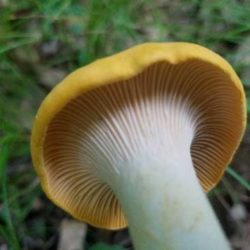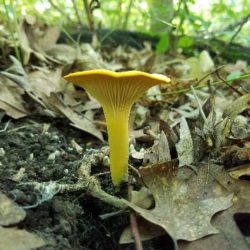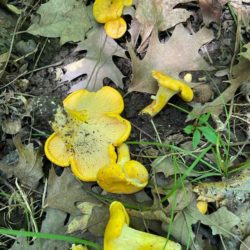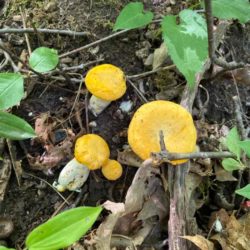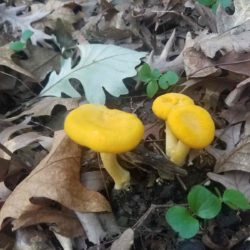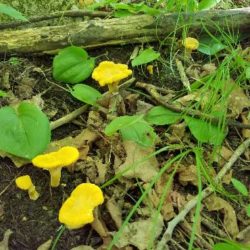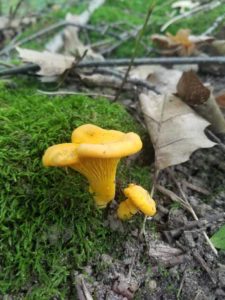
Chanterelle
Cantharellus sp. (cibarius - most common, cinnabarinus, lateritius, californicus, subalbidus)
AKA: Chants, golden chanterelle, true chanterelle, egg mushroom, girolle
Description:
Grows on the ground in oak and/or coniferous woods, cap smooth or wavy edged, pale to dark yellow color, gill-like forked ridges (“false gills”) that run down and are continuous into stalk. Strong “fruity” aroma often compared to apricots
Coolness Factor:
Very good source of vitamins C and D, beta-carotene and potassium.
Where Found:
Oaks and conifers
Mycorrhizal – has symbiotic relationship with trees. Hence, they grow around LIVING trees.
Tips:
Look on the ground in oak and conifer woods, especially mossy areas. They are very good at hiding under leaves, ferns, etc so move stuff out of the way and start squatting down closer to eye level (it is truly amazing how well a bright yellow chanterelle can hide!). The black trumpet is a close relative of the chanterelle so where you find one, you may find both!
Cleaning
A soft bristle brush works well to get any dirt or debris out from the between the gills. Look at the stem once cut for little “pinholes” that can indicate bugs. A few holes are no biggie and should be often expected, but if holes are excessive or the stem is weak, better to toss.
Cooking
Sauté in butter and/or oil is arguably the most accepted cooking method for chants. While cooking, they will first release their “juices” and then reabsorb them. Wait until this happens to ensure they are thoroughly cooked.
Preserving
Chants do not dehydrate particularly well compared to other mushrooms such as morels or oysters. We recommend sautéing and then freezing so they maintain their flavor and moisture.
Look Alikes:
 Jack-o’-lantern (Omphalotus olearius) – grow in clusters on stumps, logs and base of trees, have circular caps and unforked gills. Very orange compared to the yellow color of chanterelles. As the name suggests, yes, it is orange, but even cooler yet is that it has bioluminescent properties so it essentially “glows” in the dark (mainly the gills)!!
Jack-o’-lantern (Omphalotus olearius) – grow in clusters on stumps, logs and base of trees, have circular caps and unforked gills. Very orange compared to the yellow color of chanterelles. As the name suggests, yes, it is orange, but even cooler yet is that it has bioluminescent properties so it essentially “glows” in the dark (mainly the gills)!!

